Pathology
Liberty University
All 15 results
Sort by
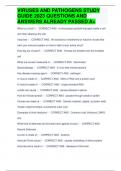
-
VIRUSES AND PATHOGENS STUDY GUIDE 2023 QUESTIONS AND ANSWERS ALREADY PASSED A+
- Exam (elaborations) • 3 pages • 2024
-
- $8.69
- + learn more
What is a virus? - CORRECT ANS a microscopic particle that gets inside a cell and often destroys the cell Vaccines - CORRECT ANS the solutions of weakened or inactive viruses that train your immune system on how to fight a real, active virus? How big are viruses? - CORRECT ANS Viruses are smaller than the smallest cell What are viruses measured in - CORRECT ANS Nanometer Bacteriophage - CORRECT ANS A virus that infects bacteria Any disease-causing agent - CORRECT ANS pathogen A virus is...
it has pathology notes on burns, the biology of cancers and tumor, altered cellular tissue biology, pathological calcification, and wound healing
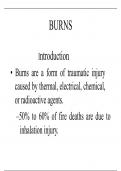
-
Pathology - Burns
- Class notes • 46 pages • 2023
- Available in package deal
-
- $12.99
- + learn more
BURNS Introduction • Burns are a form of traumatic injury caused by thermal, electrical, chemical, or radioactive agents. –50% to 60% of fire deaths are due to inhalation injury. Pathophysiology • Burn Injury • Physiologic reaction to a burn is similar to the inflammatory process. –Adjacent intact vessels dilate, causing redness and blanching with pressure. –Platelets and leukocytes begin to adhere to the vascular endothelium as an early event in the inflammatory process. Pa...
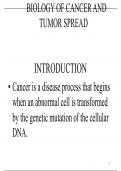
-
Biology of cancers and tumors
- Class notes • 43 pages • 2023
- Available in package deal
-
- $10.49
- + learn more
BIOLOGY OF CANCER AND TUMOR SPREAD INTRODUCTION • Cancer is a disease process that begins when an abnormal cell is transformed by the genetic mutation of the cellular DNA. • This abnormal cell forms a clone and begins to proliferate abnormally, ignoring growth-regulating signals in the environment surrounding the cell. INTRODUCTION • The cells acquire invasive characteristics, and changes occur in surrounding tissues. • The cells infiltrate these tissues and gain access to lymph ...
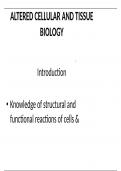
-
Altered cellular tissue biology
- Class notes • 86 pages • 2023
- Available in package deal
-
- $9.49
- + learn more
Introduction • Knowledge of structural and functional reactions of cells & tissues to injurious agents - key in understanding of disease processes • Altered cellular & tissue biology can result from adaptation, injury, neoplasia, aging or death CELLULAR ADAPTATION • An alteration that enables the cell to maintain a steady state despite adverse conditions • Adapted cell is neither normal nor injured –Condition – in between the two states • Forms – atrophy, hypertroph...
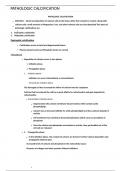
-
pathological calcification
- Class notes • 3 pages • 2023
- Available in package deal
-
- $9.99
- + learn more
PATHOLOGIC CALCIFICATION Definition – Abnormal deposition of calcium salts in the tissue other than osteoid or enamel. Along with calcium salts, small amounts of Magnesium, iron, and other mineral salts are also deposited Two types of pathologic calcifications are- 1. Dystrophic calcification 2. Metastatic calcification Dystrophic calcification Calcification occurs in dead and degenerated tissues Plasma calcium levels and Phosphate levels are normal Pathogenesis Deposition of calcium...
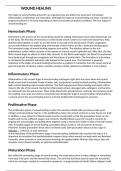
-
Wound Healing
- Class notes • 2 pages • 2023
- Available in package deal
-
- $10.99
- + learn more
The stages of wound healing proceed in an organized way and follow four processes: hemostasis, inflammation, proliferation and maturation. Although the stages of wound healing are linear, wounds can progress backward or forward depending on internal and external patient conditions. The four stages of wound healing are: Hemostasis Phase Hemostasis is the process of the wound being closed by clotting. Hemostasis starts when blood leaks out of the body. The first step of hemostasis is when blood ...
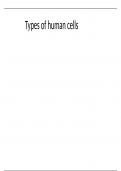
-
Types of human cells
- Class notes • 20 pages • 2023
-
- $10.89
- + learn more
Introduction • Cells in the human body may be based on –tissue formation –on their function Human body cells based on tissue formation • 1.Bone cells (Osteocytes) -toughest body Cell since they are bound together by calcium and phosphate • They give strength, support and frame-work to the body by enclosing organs in skeletal system i.e bones. • 2.Cartilage cells (chondrocytes)– similar to bone cells but the surrounding material is just loose and flexible ...

-
PATHOLOGY - INFLAMMATION
- Class notes • 66 pages • 2023
-
- $10.49
- + learn more
Introduction • Inflammation is a defensive reaction intended to neutralize, control, or eliminate the offending agent and to prepare the site for repair. • Meant to serve a protective function. • Occurs in cell injury events, such as strokes and myocardial infarctions. Introduction • Inflammation is an adaptive response to noxious conditions-an attempt to restore homeostasis • Inflammation can be induced by immune recognition that is hypersensitive to environmental components...

-
Pathology - haemorrhage
- Class notes • 33 pages • 2023
-
- $10.49
- + learn more
Introduction • Hemorrhage is extravasation of blood outside the blood vessel. • Hematoma-Hemorrhage enclosed within a tissue or a cavity • Exsanguination- total loss of blood • Desanguination- major loss • Hemorrhage is one of the basic problems and considerations in surgery • From trivial trauma or major abdominal organ injuries- congenital and acquired coagulation disorders • A wide spectrum of problems involves hemorrhage Classification of hemorrhage According t...

Do you wonder why so many students wear nice clothes, have money to spare and enjoy tons of free time? Well, they sell on Stuvia! Imagine your study notes being downloaded a dozen times for $15 each. Every. Single. Day. Discover all about earning on Stuvia


